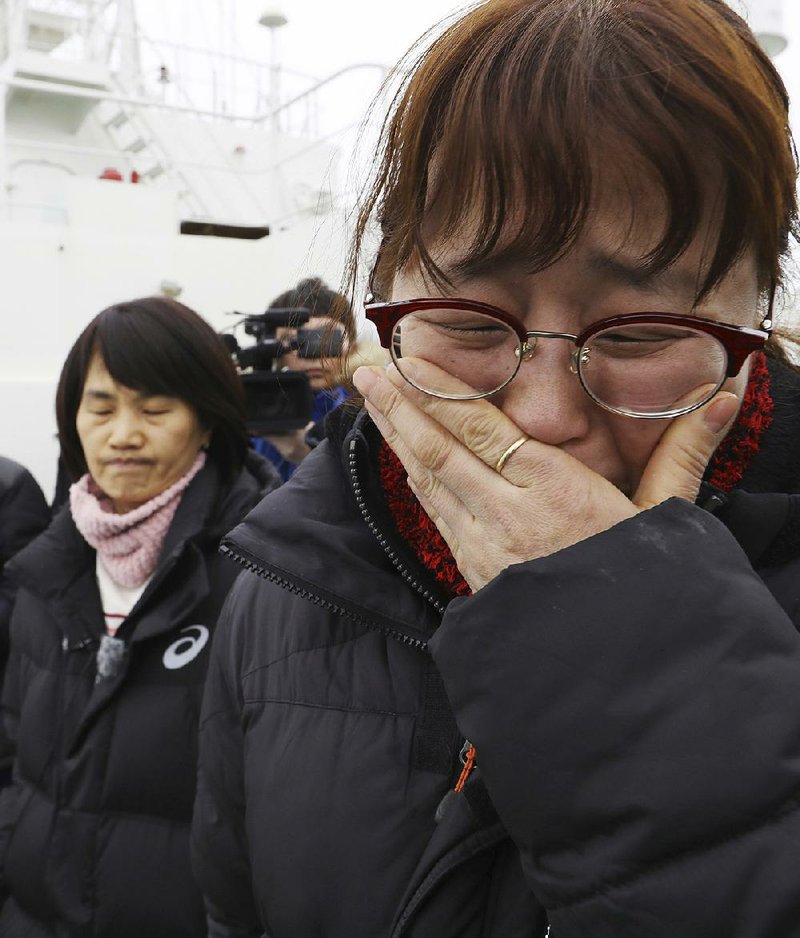SEOUL, South Korea -- South Korean efforts to move a sunken, 6,800-ton ferry back to land cleared an obstacle this morning after divers cut off a vehicle ramp that had been dangling from the ship and hindering efforts to raise the ferry.
Removing the ramp will allow workers to raise the ferry to a height where it can be loaded onto a semi-submersible transport vessel for transportation to a port.
More than 300 people -- most of them students on a high school trip -- died when the Sewol ferry sank on April 16, 2014, touching off an outpouring of national grief and soul searching about long-ignored public safety and regulatory failures. Public anger over what was seen as a botched rescue job by the government contributed to the recent ouster of Park Geun-hye as president.
Salvage crews plan to raise the Sewol until its upper side is about 42 feet above the water's surface so that the ferry can be loaded onto the transport vessel about a mile away. It was just short of that height early this morning, according to the Ministry of Oceans and Fisheries.
It would not have been possible to fit the ferry onto the transport vessel with the ramp hanging down, and a government official said removing it should give workers enough time to load the ferry by midnight today.
The water where the ferry sank is notorious for dangerous currents. The sea is relatively calm now, but currents are forecast to strengthen Saturday.
Workers on two barges began the salvaging operation Wednesday night, rolling up 66 cables connected to a frame of metal beams that divers spent months placing under the ferry.
The bodies of 295 passengers were found after the sinking, but nine are still missing. Relatives, some of whom were watching from two fishing boats just outside the salvage operation area, hope those remains will be found inside the ferry. Some cried as they took turns watching the emerging wreckage with telescopes.
"I shouted in joy when we heard that the ship surfaced at dawn. I thought we finally can find the missing nine," Lee Geum-hee, the mother of a missing school girl, told a television crew.
"But when I actually saw the ship coming up, I was devastated. All this time my poor child was in that cold, dirty place. It was heart-wrenching."
If the Sewol is successfully loaded onto the transport vessel, it will take days to empty the ferry of water and fuel, and another two weeks for the ferry to reach a port about 55 miles away in the city of Mokpo.
Workers will then begin clearing mud and debris, and search for the remains of the missing victims. An investigation committee will also search for clues that could further explain the cause of the sinking, which has been blamed on overloaded cargo, improper storage and other negligence.
A group representing the families of the victims issued a statement demanding that it be part of the investigation committee. Many bereaved family members and their supporters have been demanding a more thorough investigation of the government's responsibility in the sinking, questioning why higher-level officials have not been held accountable.
The ferry's captain survived and is serving a life sentence after a court found him guilty of committing homicide through "willful negligence" because he fled the ship without issuing an evacuation order.
Ousted President Park was forced to defend herself against accusations that she was out of contact for several hours on the day of the sinking. The allegations were included in an impeachment bill lawmakers passed against Park in December, amid broader corruption suspicions. Park was formally removed from office by the Constitutional Court earlier this month.
Salvaging the huge, corroded ferry has been a difficult and expensive job. South Korea agreed in 2015 to a $76 million deal with a consortium led by China's state-run Shanghai Salvage Co. to do it.
While many large shipwrecks around the world have first been cut into sections to be raised, this was never an option for Sewol because there are hopes of finding the remains of the missing victims inside the wreckage.
A Section on 03/24/2017
